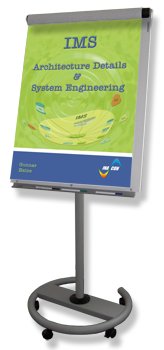 The IP Multimedia Subsystem (IMS) -
The IP Multimedia Subsystem (IMS) -
Architecture Details & System Engineering
[3-day course, Euro 3,450.- (net) per participant]
 The Service and Business Perspective of the IMS
The Service and Business Perspective of the IMS
(IP Multimedia Subsystem)

- The IMS enables the Multimedia Marketplace
Positioning of the IMS, Differentiation of Service Delivery Platform and IMS, Presentation of typical Application Servers (OSA, PoC, …) - Why is the IMS needed?
Standardized Realization of Charging, Roaming, QoS and Service Integration, IMS Use outside 3GPP - The Business Case behind the IMS
What are Triple Play Services?, Competition by Cable-TV and fixed line operators - How to introduce the IMS
Phased Approach, from non-real-time services to real-time services - Service Examples
Multimedia Group or Broadcast Calls, Clearing Services, Presence Services, Gaming Services, GTT (Global Text and Total Conversation), Instant Messaging, Home Monitoring, White Board Communication, Push-to-Video (“see what I see”), … - Use Cases
High level view on session setup and release, SIP involvement, Replacement of the circuit-switched core network domain
 Components / Architecture of the IMS
Components / Architecture of the IMS
- X-CSCF
Overview P-CSCF, I-CSCF, S-CSCF, the genuine SIP-Proxy and SIP-Registrar, Tasks and Functions, Operation Examples, PDF (Policy Decision Function) - BGCF and MGCF
Overview, Tasks and Functions, Operation Examples - MRFC and MRFP
Overview, Tasks and Functions, Operation Examples - Media Gateways
Soft Switch Operation, Interworking with IMS-Controllers (MGCF) - The HSS (Home Subscriber Server)
Information is stored in the HSS, Operation of SGW’s, Private and Public User Identities, the ISIM, Security Associations, information exchange over the Cx- and Dx-Interfaces - Related Network Elements
SLF (Subscriber Locator Function), ENUM-Server, DiffServ-Routers, SEG (Security Gateways), Interworking with the packet-switched core network domain. - Application Servers
Gaming, Presence, …, Architecture and Details of the ISC-Interfaces, OSA-Servers, involvement of .net and other environments for application development
 The Protocol Suite of the IMS
The Protocol Suite of the IMS
- Overview
SIP, SDP, COPS, DBP, H.248 (MEGACO), RSVP, RTP, RTCP, Position in the Protocol Stack, Default Port Numbers - SIP and SDP
Tasks and Functions, SIP-Method Types, important SDP-Descriptors, Functional Examples - RTP and RTCP
Tasks and Functions, Codec Types, important SDP-Descriptors, Functional Examples
 Typical Use Scenarios
Typical Use Scenarios
- Application Level Registration
Overview, P-CSCF-Discovery Procedure, SIP-Registration, S-CSCF-Assignment, Applicability of this Procedure, Message Flow - Multimedia Session Setup and Release
Overview, QoS-Policing, Invocation of Authentication and Encryption, Codec Selection, Applicability of this Procedure, Message Flow, Charging Options
 Focusing on Advanced Issues: Security, QoS,...
Focusing on Advanced Issues: Security, QoS,...
- QoS-Control in the IMS
QoS-Authorization, SBLP (Service Based Local Policy), Function of the PDF, COPS-Involvement, Bearer Assignment, DiffServIntServ / Packet Inspection - Security Mechanisms in the IMS
Security Concept, SPD and SAD, IMS-AKA, SIM-AKA, Profiling of IPsec for the IMS, Authentication Vectors, Authentication Scenarios, Integrity Protection, Assignment of SA’s, Involvement of SEG’s, - Roaming Scenarios
Registration in a visited PLMN, S-CSCF Allocation, Charging
v1.2
ℹ️ Try out the updated search below!
Search:
More Info:
General Information about this course
Schedule of this training course
Extract of this training course
Buy this book
Buy this book as eBook
INACON eBooks
Please have a look at our full offer

